Ultimate Resource For Cambridge Assessment International Education
One-word essays.
The good thing about one word essays is that you can write it as a narrative, as an inspirational essay or as an essay describing an attribute of life.
Starting the essay:
- Add a quote relevant to the topic, it generally helps. Don’t just make up bizarre quotes, if you know a quote then add it, if you don’t then no problem.
- Start the essay in a open manner, describe the word and it’s importance (if you’re not going towards narrative style). For example: “ Dreams – Dreams are an essential part of life, they are a collection of all the emotions and sensations of a person gathered into a real life play. “
The main body should be composed of how the attributes work as an inspirational, important part of life. For example: “ Dreams act as an inspiration for people. Everyone dreams about what is hidden deep within their minds, something they desire, something they thrive for. When a person dreams about something he/she wants, he/she feels rejuvenated and inspired to do something to fulfill his dreams “.
Conclusion:
Summarize you’re thoughts about the matter and finish with a strong sentence. For Example: “ Imagine a person who does not dream – how envious he would feel; nothing to aim at, nothing to be inspired by. “
Generally, one word essays can be very open but tough to write. You need to put in a lot of thought into the essay and hence the plan is very essential. Take your time and plan out how you will approach the essay and then write an interesting, factual account on the topic.
If you’re writing narratives on a One Word Essay, go for stories like “Success Stories”, “How Dreams Turned Into Reality”.
Example One-Word Essay on “ Success “:
The rewards one gets in life are usually the results of one’s efforts. No man can hope to have a very easy life and also at the same time a very successful one.
There may be only one or two exceptions in thousands of cases in this matter. It is astonishing what intelligent efforts can achieve when channelised in the right direction. Had success been easy, everyone would have been successful. However, the path to success is not as difficult to climb as it might appear. Each time we overcome an obstacle, the work we are attempting becomes easier.
It is very necessary to work hard to achieve success. But psychologists say that if we love our work, we will never find it hard or tiring. There is no substitute for hard work. At the same time, there should be a purpose and a noble goal at which to aim and advance. We must decide our aim in life or what we want most out of our life and then constantly work for it.
The early attempts towards the goal of success are the hardest. The more our efforts get success, the easier it becomes to do so. In the end it becomes our habit. Then success follows success. Nothing is impossible to a man who has a purpose and the perseverance to persist with it. Self-confidence, courage and strong will power are necessary to get success.
It is not how much we do but how well we do that is important. But at the same time one should also keep this in mind that it is better to do something than to do nothing due to fear of failure. It is why courage is necessary to achieve success. In the ordinary business of life industry can do anything which genius can do. Genius is nothing but quality of making persistent efforts in spite of facing thousands of failures.
Turning the pages of History, it is evident that success had never been just a matter of luck. Let’s start with the concrete example of Isaac Newton who witnessed a simple phenomenon of a falling apple, and gave a profound theory regarding ‘gravity’. It was not a matter of luck, it was his smartness that helped him give a revolutionizing theory which brought a revolution in the field of Physics. Albert Einstein, one of the pioneers in Physics, worked on problems from hours to weeks to years encountering failures after failures. Had luck been on his side, he would have given his theory in the first place. But it wasn’t luck, it was his struggle and effort which earned him glory, success and salvation in the end.
Fortune favours the brave. There is no gain without taking risk. How can a man who never ventures win? In life one has to take bold decisions quickly. Time and tide wait for nobody. The timid, weak and undecided are swept aside by the tide of time. Determination and concentration can enable a man to attain success in any field of life. So success is not a matter of luck, it depends on firm determination and full preparation.
Here are some other sample essays, read them and get an idea of how to approach the topics: http://www.scholaradvisor.com/essay-examples/narrative-essay-success-story/ http://www.shareyouressays.com/3478/846-words-short-essay-on-dreams

- Features for Creative Writers
- Features for Work
- Features for Higher Education
- Features for Teachers
- Features for Non-Native Speakers
- Learn Blog Grammar Guide Community Events FAQ
- Grammar Guide

Words to Use in an Essay: 300 Essay Words

Hannah Yang

Table of Contents
Words to use in the essay introduction, words to use in the body of the essay, words to use in your essay conclusion, how to improve your essay writing vocabulary.
It’s not easy to write an academic essay .
Many students struggle to word their arguments in a logical and concise way.
To make matters worse, academic essays need to adhere to a certain level of formality, so we can’t always use the same word choices in essay writing that we would use in daily life.
If you’re struggling to choose the right words for your essay, don’t worry—you’ve come to the right place!
In this article, we’ve compiled a list of over 300 words and phrases to use in the introduction, body, and conclusion of your essay.
The introduction is one of the hardest parts of an essay to write.
You have only one chance to make a first impression, and you want to hook your reader. If the introduction isn’t effective, the reader might not even bother to read the rest of the essay.
That’s why it’s important to be thoughtful and deliberate with the words you choose at the beginning of your essay.
Many students use a quote in the introductory paragraph to establish credibility and set the tone for the rest of the essay.
When you’re referencing another author or speaker, try using some of these phrases:
To use the words of X
According to X
As X states
Example: To use the words of Hillary Clinton, “You cannot have maternal health without reproductive health.”
Near the end of the introduction, you should state the thesis to explain the central point of your paper.
If you’re not sure how to introduce your thesis, try using some of these phrases:
In this essay, I will…
The purpose of this essay…
This essay discusses…
In this paper, I put forward the claim that…
There are three main arguments for…

Example: In this essay, I will explain why dress codes in public schools are detrimental to students.
After you’ve stated your thesis, it’s time to start presenting the arguments you’ll use to back up that central idea.
When you’re introducing the first of a series of arguments, you can use the following words:
First and foremost
First of all
To begin with
Example: First , consider the effects that this new social security policy would have on low-income taxpayers.
All these words and phrases will help you create a more successful introduction and convince your audience to read on.
The body of your essay is where you’ll explain your core arguments and present your evidence.
It’s important to choose words and phrases for the body of your essay that will help the reader understand your position and convince them you’ve done your research.
Let’s look at some different types of words and phrases that you can use in the body of your essay, as well as some examples of what these words look like in a sentence.
Transition Words and Phrases
Transitioning from one argument to another is crucial for a good essay.
It’s important to guide your reader from one idea to the next so they don’t get lost or feel like you’re jumping around at random.
Transition phrases and linking words show your reader you’re about to move from one argument to the next, smoothing out their reading experience. They also make your writing look more professional.
The simplest transition involves moving from one idea to a separate one that supports the same overall argument. Try using these phrases when you want to introduce a second correlating idea:
Additionally
In addition
Furthermore
Another key thing to remember
In the same way
Correspondingly
Example: Additionally , public parks increase property value because home buyers prefer houses that are located close to green, open spaces.
Another type of transition involves restating. It’s often useful to restate complex ideas in simpler terms to help the reader digest them. When you’re restating an idea, you can use the following words:
In other words
To put it another way
That is to say
To put it more simply
Example: “The research showed that 53% of students surveyed expressed a mild or strong preference for more on-campus housing. In other words , over half the students wanted more dormitory options.”
Often, you’ll need to provide examples to illustrate your point more clearly for the reader. When you’re about to give an example of something you just said, you can use the following words:
For instance
To give an illustration of
To exemplify
To demonstrate
As evidence
Example: Humans have long tried to exert control over our natural environment. For instance , engineers reversed the Chicago River in 1900, causing it to permanently flow backward.
Sometimes, you’ll need to explain the impact or consequence of something you’ve just said.
When you’re drawing a conclusion from evidence you’ve presented, try using the following words:
As a result
Accordingly
As you can see
This suggests that
It follows that
It can be seen that
For this reason
For all of those reasons
Consequently
Example: “There wasn’t enough government funding to support the rest of the physics experiment. Thus , the team was forced to shut down their experiment in 1996.”

When introducing an idea that bolsters one you’ve already stated, or adds another important aspect to that same argument, you can use the following words:
What’s more
Not only…but also
Not to mention
To say nothing of
Another key point
Example: The volcanic eruption disrupted hundreds of thousands of people. Moreover , it impacted the local flora and fauna as well, causing nearly a hundred species to go extinct.
Often, you'll want to present two sides of the same argument. When you need to compare and contrast ideas, you can use the following words:
On the one hand / on the other hand
Alternatively
In contrast to
On the contrary
By contrast
In comparison
Example: On the one hand , the Black Death was undoubtedly a tragedy because it killed millions of Europeans. On the other hand , it created better living conditions for the peasants who survived.
Finally, when you’re introducing a new angle that contradicts your previous idea, you can use the following phrases:
Having said that
Differing from
In spite of
With this in mind
Provided that
Nevertheless
Nonetheless
Notwithstanding
Example: Shakespearean plays are classic works of literature that have stood the test of time. Having said that , I would argue that Shakespeare isn’t the most accessible form of literature to teach students in the twenty-first century.
Good essays include multiple types of logic. You can use a combination of the transitions above to create a strong, clear structure throughout the body of your essay.
Strong Verbs for Academic Writing
Verbs are especially important for writing clear essays. Often, you can convey a nuanced meaning simply by choosing the right verb.
You should use strong verbs that are precise and dynamic. Whenever possible, you should use an unambiguous verb, rather than a generic verb.
For example, alter and fluctuate are stronger verbs than change , because they give the reader more descriptive detail.
Here are some useful verbs that will help make your essay shine.
Verbs that show change:
Accommodate
Verbs that relate to causing or impacting something:
Verbs that show increase:
Verbs that show decrease:
Deteriorate
Verbs that relate to parts of a whole:
Comprises of
Is composed of
Constitutes
Encompasses
Incorporates
Verbs that show a negative stance:
Misconstrue

Verbs that show a positive stance:
Substantiate
Verbs that relate to drawing conclusions from evidence:
Corroborate
Demonstrate
Verbs that relate to thinking and analysis:
Contemplate
Hypothesize
Investigate
Verbs that relate to showing information in a visual format:
Useful Adjectives and Adverbs for Academic Essays
You should use adjectives and adverbs more sparingly than verbs when writing essays, since they sometimes add unnecessary fluff to sentences.
However, choosing the right adjectives and adverbs can help add detail and sophistication to your essay.
Sometimes you'll need to use an adjective to show that a finding or argument is useful and should be taken seriously. Here are some adjectives that create positive emphasis:
Significant
Other times, you'll need to use an adjective to show that a finding or argument is harmful or ineffective. Here are some adjectives that create a negative emphasis:
Controversial
Insignificant
Questionable
Unnecessary
Unrealistic
Finally, you might need to use an adverb to lend nuance to a sentence, or to express a specific degree of certainty. Here are some examples of adverbs that are often used in essays:
Comprehensively
Exhaustively
Extensively
Respectively
Surprisingly
Using these words will help you successfully convey the key points you want to express. Once you’ve nailed the body of your essay, it’s time to move on to the conclusion.
The conclusion of your paper is important for synthesizing the arguments you’ve laid out and restating your thesis.
In your concluding paragraph, try using some of these essay words:
In conclusion
To summarize
In a nutshell
Given the above
As described
All things considered
Example: In conclusion , it’s imperative that we take action to address climate change before we lose our coral reefs forever.
In addition to simply summarizing the key points from the body of your essay, you should also add some final takeaways. Give the reader your final opinion and a bit of a food for thought.
To place emphasis on a certain point or a key fact, use these essay words:
Unquestionably
Undoubtedly
Particularly
Importantly
Conclusively
It should be noted
On the whole
Example: Ada Lovelace is unquestionably a powerful role model for young girls around the world, and more of our public school curricula should include her as a historical figure.
These concluding phrases will help you finish writing your essay in a strong, confident way.
There are many useful essay words out there that we didn't include in this article, because they are specific to certain topics.
If you're writing about biology, for example, you will need to use different terminology than if you're writing about literature.
So how do you improve your vocabulary skills?
The vocabulary you use in your academic writing is a toolkit you can build up over time, as long as you take the time to learn new words.
One way to increase your vocabulary is by looking up words you don’t know when you’re reading.
Try reading more books and academic articles in the field you’re writing about and jotting down all the new words you find. You can use these words to bolster your own essays.
You can also consult a dictionary or a thesaurus. When you’re using a word you’re not confident about, researching its meaning and common synonyms can help you make sure it belongs in your essay.
Don't be afraid of using simpler words. Good essay writing boils down to choosing the best word to convey what you need to say, not the fanciest word possible.
Finally, you can use ProWritingAid’s synonym tool or essay checker to find more precise and sophisticated vocabulary. Click on weak words in your essay to find stronger alternatives.

There you have it: our compilation of the best words and phrases to use in your next essay . Good luck!

Good writing = better grades
ProWritingAid will help you improve the style, strength, and clarity of all your assignments.
Hannah Yang is a speculative fiction writer who writes about all things strange and surreal. Her work has appeared in Analog Science Fiction, Apex Magazine, The Dark, and elsewhere, and two of her stories have been finalists for the Locus Award. Her favorite hobbies include watercolor painting, playing guitar, and rock climbing. You can follow her work on hannahyang.com, or subscribe to her newsletter for publication updates.
Get started with ProWritingAid
Drop us a line or let's stay in touch via :
Places on our 2024 summer school are filling fast. Don’t miss out. Enrol now to avoid disappointment
- 40 Useful Words and Phrases for Top-Notch Essays

To be truly brilliant, an essay needs to utilise the right language. You could make a great point, but if it’s not intelligently articulated, you almost needn’t have bothered.
Developing the language skills to build an argument and to write persuasively is crucial if you’re to write outstanding essays every time. In this article, we’re going to equip you with the words and phrases you need to write a top-notch essay, along with examples of how to utilise them.
It’s by no means an exhaustive list, and there will often be other ways of using the words and phrases we describe that we won’t have room to include, but there should be more than enough below to help you make an instant improvement to your essay-writing skills.
If you’re interested in developing your language and persuasive skills, Oxford Royale offers summer courses at its Oxford Summer School , Cambridge Summer School , London Summer School , San Francisco Summer School and Yale Summer School . You can study courses to learn english , prepare for careers in law , medicine , business , engineering and leadership.
General explaining
Let’s start by looking at language for general explanations of complex points.
1. In order to
Usage: “In order to” can be used to introduce an explanation for the purpose of an argument. Example: “In order to understand X, we need first to understand Y.”
2. In other words
Usage: Use “in other words” when you want to express something in a different way (more simply), to make it easier to understand, or to emphasise or expand on a point. Example: “Frogs are amphibians. In other words, they live on the land and in the water.”
3. To put it another way
Usage: This phrase is another way of saying “in other words”, and can be used in particularly complex points, when you feel that an alternative way of wording a problem may help the reader achieve a better understanding of its significance. Example: “Plants rely on photosynthesis. To put it another way, they will die without the sun.”
4. That is to say
Usage: “That is” and “that is to say” can be used to add further detail to your explanation, or to be more precise. Example: “Whales are mammals. That is to say, they must breathe air.”
5. To that end
Usage: Use “to that end” or “to this end” in a similar way to “in order to” or “so”. Example: “Zoologists have long sought to understand how animals communicate with each other. To that end, a new study has been launched that looks at elephant sounds and their possible meanings.”
Adding additional information to support a point
Students often make the mistake of using synonyms of “and” each time they want to add further information in support of a point they’re making, or to build an argument . Here are some cleverer ways of doing this.
6. Moreover
Usage: Employ “moreover” at the start of a sentence to add extra information in support of a point you’re making. Example: “Moreover, the results of a recent piece of research provide compelling evidence in support of…”
7. Furthermore
Usage:This is also generally used at the start of a sentence, to add extra information. Example: “Furthermore, there is evidence to suggest that…”
8. What’s more
Usage: This is used in the same way as “moreover” and “furthermore”. Example: “What’s more, this isn’t the only evidence that supports this hypothesis.”
9. Likewise
Usage: Use “likewise” when you want to talk about something that agrees with what you’ve just mentioned. Example: “Scholar A believes X. Likewise, Scholar B argues compellingly in favour of this point of view.”
10. Similarly
Usage: Use “similarly” in the same way as “likewise”. Example: “Audiences at the time reacted with shock to Beethoven’s new work, because it was very different to what they were used to. Similarly, we have a tendency to react with surprise to the unfamiliar.”
11. Another key thing to remember
Usage: Use the phrase “another key point to remember” or “another key fact to remember” to introduce additional facts without using the word “also”. Example: “As a Romantic, Blake was a proponent of a closer relationship between humans and nature. Another key point to remember is that Blake was writing during the Industrial Revolution, which had a major impact on the world around him.”
12. As well as
Usage: Use “as well as” instead of “also” or “and”. Example: “Scholar A argued that this was due to X, as well as Y.”
13. Not only… but also
Usage: This wording is used to add an extra piece of information, often something that’s in some way more surprising or unexpected than the first piece of information. Example: “Not only did Edmund Hillary have the honour of being the first to reach the summit of Everest, but he was also appointed Knight Commander of the Order of the British Empire.”
14. Coupled with
Usage: Used when considering two or more arguments at a time. Example: “Coupled with the literary evidence, the statistics paint a compelling view of…”
15. Firstly, secondly, thirdly…
Usage: This can be used to structure an argument, presenting facts clearly one after the other. Example: “There are many points in support of this view. Firstly, X. Secondly, Y. And thirdly, Z.
16. Not to mention/to say nothing of
Usage: “Not to mention” and “to say nothing of” can be used to add extra information with a bit of emphasis. Example: “The war caused unprecedented suffering to millions of people, not to mention its impact on the country’s economy.”
Words and phrases for demonstrating contrast
When you’re developing an argument, you will often need to present contrasting or opposing opinions or evidence – “it could show this, but it could also show this”, or “X says this, but Y disagrees”. This section covers words you can use instead of the “but” in these examples, to make your writing sound more intelligent and interesting.
17. However
Usage: Use “however” to introduce a point that disagrees with what you’ve just said. Example: “Scholar A thinks this. However, Scholar B reached a different conclusion.”
18. On the other hand
Usage: Usage of this phrase includes introducing a contrasting interpretation of the same piece of evidence, a different piece of evidence that suggests something else, or an opposing opinion. Example: “The historical evidence appears to suggest a clear-cut situation. On the other hand, the archaeological evidence presents a somewhat less straightforward picture of what happened that day.”
19. Having said that
Usage: Used in a similar manner to “on the other hand” or “but”. Example: “The historians are unanimous in telling us X, an agreement that suggests that this version of events must be an accurate account. Having said that, the archaeology tells a different story.”
20. By contrast/in comparison
Usage: Use “by contrast” or “in comparison” when you’re comparing and contrasting pieces of evidence. Example: “Scholar A’s opinion, then, is based on insufficient evidence. By contrast, Scholar B’s opinion seems more plausible.”
21. Then again
Usage: Use this to cast doubt on an assertion. Example: “Writer A asserts that this was the reason for what happened. Then again, it’s possible that he was being paid to say this.”
22. That said
Usage: This is used in the same way as “then again”. Example: “The evidence ostensibly appears to point to this conclusion. That said, much of the evidence is unreliable at best.”
Usage: Use this when you want to introduce a contrasting idea. Example: “Much of scholarship has focused on this evidence. Yet not everyone agrees that this is the most important aspect of the situation.”
Adding a proviso or acknowledging reservations
Sometimes, you may need to acknowledge a shortfalling in a piece of evidence, or add a proviso. Here are some ways of doing so.
24. Despite this
Usage: Use “despite this” or “in spite of this” when you want to outline a point that stands regardless of a shortfalling in the evidence. Example: “The sample size was small, but the results were important despite this.”
25. With this in mind
Usage: Use this when you want your reader to consider a point in the knowledge of something else. Example: “We’ve seen that the methods used in the 19th century study did not always live up to the rigorous standards expected in scientific research today, which makes it difficult to draw definite conclusions. With this in mind, let’s look at a more recent study to see how the results compare.”
26. Provided that
Usage: This means “on condition that”. You can also say “providing that” or just “providing” to mean the same thing. Example: “We may use this as evidence to support our argument, provided that we bear in mind the limitations of the methods used to obtain it.”
27. In view of/in light of
Usage: These phrases are used when something has shed light on something else. Example: “In light of the evidence from the 2013 study, we have a better understanding of…”
28. Nonetheless
Usage: This is similar to “despite this”. Example: “The study had its limitations, but it was nonetheless groundbreaking for its day.”
29. Nevertheless
Usage: This is the same as “nonetheless”. Example: “The study was flawed, but it was important nevertheless.”
30. Notwithstanding
Usage: This is another way of saying “nonetheless”. Example: “Notwithstanding the limitations of the methodology used, it was an important study in the development of how we view the workings of the human mind.”
Giving examples
Good essays always back up points with examples, but it’s going to get boring if you use the expression “for example” every time. Here are a couple of other ways of saying the same thing.
31. For instance
Example: “Some birds migrate to avoid harsher winter climates. Swallows, for instance, leave the UK in early winter and fly south…”
32. To give an illustration
Example: “To give an illustration of what I mean, let’s look at the case of…”
Signifying importance
When you want to demonstrate that a point is particularly important, there are several ways of highlighting it as such.
33. Significantly
Usage: Used to introduce a point that is loaded with meaning that might not be immediately apparent. Example: “Significantly, Tacitus omits to tell us the kind of gossip prevalent in Suetonius’ accounts of the same period.”
34. Notably
Usage: This can be used to mean “significantly” (as above), and it can also be used interchangeably with “in particular” (the example below demonstrates the first of these ways of using it). Example: “Actual figures are notably absent from Scholar A’s analysis.”
35. Importantly
Usage: Use “importantly” interchangeably with “significantly”. Example: “Importantly, Scholar A was being employed by X when he wrote this work, and was presumably therefore under pressure to portray the situation more favourably than he perhaps might otherwise have done.”
Summarising
You’ve almost made it to the end of the essay, but your work isn’t over yet. You need to end by wrapping up everything you’ve talked about, showing that you’ve considered the arguments on both sides and reached the most likely conclusion. Here are some words and phrases to help you.
36. In conclusion
Usage: Typically used to introduce the concluding paragraph or sentence of an essay, summarising what you’ve discussed in a broad overview. Example: “In conclusion, the evidence points almost exclusively to Argument A.”
37. Above all
Usage: Used to signify what you believe to be the most significant point, and the main takeaway from the essay. Example: “Above all, it seems pertinent to remember that…”
38. Persuasive
Usage: This is a useful word to use when summarising which argument you find most convincing. Example: “Scholar A’s point – that Constanze Mozart was motivated by financial gain – seems to me to be the most persuasive argument for her actions following Mozart’s death.”
39. Compelling
Usage: Use in the same way as “persuasive” above. Example: “The most compelling argument is presented by Scholar A.”
40. All things considered
Usage: This means “taking everything into account”. Example: “All things considered, it seems reasonable to assume that…”
How many of these words and phrases will you get into your next essay? And are any of your favourite essay terms missing from our list? Let us know in the comments below, or get in touch here to find out more about courses that can help you with your essays.
At Oxford Royale Academy, we offer a number of summer school courses for young people who are keen to improve their essay writing skills. Click here to apply for one of our courses today, including law , business , medicine and engineering .
Comments are closed.

100+ Useful Words and Phrases to Write a Great Essay
By: Author Sophia
Posted on Last updated: October 25, 2023
Sharing is caring!
How to Write a Great Essay in English! This lesson provides 100+ useful words, transition words and expressions used in writing an essay. Let’s take a look!
The secret to a successful essay doesn’t just lie in the clever things you talk about and the way you structure your points.
Useful Words and Phrases to Write a Great Essay
Overview of an essay.

Useful Phrases for Proficiency Essays
Developing the argument
- The first aspect to point out is that…
- Let us start by considering the facts.
- The novel portrays, deals with, revolves around…
- Central to the novel is…
- The character of xxx embodies/ epitomizes…
The other side of the argument
- It would also be interesting to see…
- One should, nevertheless, consider the problem from another angle.
- Equally relevant to the issue are the questions of…
- The arguments we have presented… suggest that…/ prove that…/ would indicate that…
- From these arguments one must…/ could…/ might… conclude that…
- All of this points to the conclusion that…
- To conclude…
Ordering elements
- Firstly,…/ Secondly,…/ Finally,… (note the comma after all these introductory words.)
- As a final point…
- On the one hand, …. on the other hand…
- If on the one hand it can be said that… the same is not true for…
- The first argument suggests that… whilst the second suggests that…
- There are at least xxx points to highlight.
Adding elements
- Furthermore, one should not forget that…
- In addition to…
- Moreover…
- It is important to add that…
Accepting other points of view
- Nevertheless, one should accept that…
- However, we also agree that…
Personal opinion
- We/I personally believe that…
- Our/My own point of view is that…
- It is my contention that…
- I am convinced that…
- My own opinion is…
Others’ opinions
- According to some critics… Critics:
- believe that
- suggest that
- are convinced that
- point out that
- emphasize that
- contend that
- go as far as to say that
- argue for this
Introducing examples
- For example…
- For instance…
- To illustrate this point…
Introducing facts
- It is… true that…/ clear that…/ noticeable that…
- One should note here that…
Saying what you think is true
- This leads us to believe that…
- It is very possible that…
- In view of these facts, it is quite likely that…
- Doubtless,…
- One cannot deny that…
- It is (very) clear from these observations that…
- All the same, it is possible that…
- It is difficult to believe that…
Accepting other points to a certain degree
- One can agree up to a certain point with…
- Certainly,… However,…
- It cannot be denied that…
Emphasizing particular points
- The last example highlights the fact that…
- Not only… but also…
- We would even go so far as to say that…
Moderating, agreeing, disagreeing
- By and large…
- Perhaps we should also point out the fact that…
- It would be unfair not to mention the fact that…
- One must admit that…
- We cannot ignore the fact that…
- One cannot possibly accept the fact that…
Consequences
- From these facts, one may conclude that…
- That is why, in our opinion, …
- Which seems to confirm the idea that…
- Thus,…/ Therefore,…
- Some critics suggest…, whereas others…
- Compared to…
- On the one hand, there is the firm belief that… On the other hand, many people are convinced that…
How to Write a Great Essay | Image 1

How to Write a Great Essay | Image 2

Phrases For Balanced Arguments
Introduction
- It is often said that…
- It is undeniable that…
- It is a well-known fact that…
- One of the most striking features of this text is…
- The first thing that needs to be said is…
- First of all, let us try to analyze…
- One argument in support of…
- We must distinguish carefully between…
- The second reason for…
- An important aspect of the text is…
- It is worth stating at this point that…
- On the other hand, we can observe that…
- The other side of the coin is, however, that…
- Another way of looking at this question is to…
- What conclusions can be drawn from all this?
- The most satisfactory conclusion that we can come to is…
- To sum up… we are convinced that…/ …we believe that…/ …we have to accept that…
How to Write a Great Essay | Image 3

- Recent Posts
- Plural of Process in the English Grammar - October 3, 2023
- Best Kahoot Names: Get Creative with These Fun Ideas! - October 2, 2023
- List of Homophones for English Learners - September 30, 2023
Related posts:
- How to Write a Formal Letter | Useful Phrases with ESL Image
- 50+ Questions to Start a Conversation with Anyone in English
- Useful English Greetings and Expressions for English Learners
- Asking for Help, Asking for Opinions and Asking for Approval
Nur Syuhadah Zainuddin
Friday 19th of August 2022
thank u so much its really usefull
12thSeahorse
Wednesday 3rd of August 2022
He or she who masters the English language rules the world!
Friday 25th of March 2022
Thank you so so much, this helped me in my essays with A+
Theophilus Muzvidziwa
Friday 11th of March 2022
Monday 21st of February 2022

Comparing and Contrasting
What this handout is about.
This handout will help you first to determine whether a particular assignment is asking for comparison/contrast and then to generate a list of similarities and differences, decide which similarities and differences to focus on, and organize your paper so that it will be clear and effective. It will also explain how you can (and why you should) develop a thesis that goes beyond “Thing A and Thing B are similar in many ways but different in others.”
Introduction
In your career as a student, you’ll encounter many different kinds of writing assignments, each with its own requirements. One of the most common is the comparison/contrast essay, in which you focus on the ways in which certain things or ideas—usually two of them—are similar to (this is the comparison) and/or different from (this is the contrast) one another. By assigning such essays, your instructors are encouraging you to make connections between texts or ideas, engage in critical thinking, and go beyond mere description or summary to generate interesting analysis: when you reflect on similarities and differences, you gain a deeper understanding of the items you are comparing, their relationship to each other, and what is most important about them.
Recognizing comparison/contrast in assignments
Some assignments use words—like compare, contrast, similarities, and differences—that make it easy for you to see that they are asking you to compare and/or contrast. Here are a few hypothetical examples:
- Compare and contrast Frye’s and Bartky’s accounts of oppression.
- Compare WWI to WWII, identifying similarities in the causes, development, and outcomes of the wars.
- Contrast Wordsworth and Coleridge; what are the major differences in their poetry?
Notice that some topics ask only for comparison, others only for contrast, and others for both.
But it’s not always so easy to tell whether an assignment is asking you to include comparison/contrast. And in some cases, comparison/contrast is only part of the essay—you begin by comparing and/or contrasting two or more things and then use what you’ve learned to construct an argument or evaluation. Consider these examples, noticing the language that is used to ask for the comparison/contrast and whether the comparison/contrast is only one part of a larger assignment:
- Choose a particular idea or theme, such as romantic love, death, or nature, and consider how it is treated in two Romantic poems.
- How do the different authors we have studied so far define and describe oppression?
- Compare Frye’s and Bartky’s accounts of oppression. What does each imply about women’s collusion in their own oppression? Which is more accurate?
- In the texts we’ve studied, soldiers who served in different wars offer differing accounts of their experiences and feelings both during and after the fighting. What commonalities are there in these accounts? What factors do you think are responsible for their differences?
You may want to check out our handout on understanding assignments for additional tips.
Using comparison/contrast for all kinds of writing projects
Sometimes you may want to use comparison/contrast techniques in your own pre-writing work to get ideas that you can later use for an argument, even if comparison/contrast isn’t an official requirement for the paper you’re writing. For example, if you wanted to argue that Frye’s account of oppression is better than both de Beauvoir’s and Bartky’s, comparing and contrasting the main arguments of those three authors might help you construct your evaluation—even though the topic may not have asked for comparison/contrast and the lists of similarities and differences you generate may not appear anywhere in the final draft of your paper.
Discovering similarities and differences
Making a Venn diagram or a chart can help you quickly and efficiently compare and contrast two or more things or ideas. To make a Venn diagram, simply draw some overlapping circles, one circle for each item you’re considering. In the central area where they overlap, list the traits the two items have in common. Assign each one of the areas that doesn’t overlap; in those areas, you can list the traits that make the things different. Here’s a very simple example, using two pizza places:

To make a chart, figure out what criteria you want to focus on in comparing the items. Along the left side of the page, list each of the criteria. Across the top, list the names of the items. You should then have a box per item for each criterion; you can fill the boxes in and then survey what you’ve discovered.
Here’s an example, this time using three pizza places:
As you generate points of comparison, consider the purpose and content of the assignment and the focus of the class. What do you think the professor wants you to learn by doing this comparison/contrast? How does it fit with what you have been studying so far and with the other assignments in the course? Are there any clues about what to focus on in the assignment itself?
Here are some general questions about different types of things you might have to compare. These are by no means complete or definitive lists; they’re just here to give you some ideas—you can generate your own questions for these and other types of comparison. You may want to begin by using the questions reporters traditionally ask: Who? What? Where? When? Why? How? If you’re talking about objects, you might also consider general properties like size, shape, color, sound, weight, taste, texture, smell, number, duration, and location.
Two historical periods or events
- When did they occur—do you know the date(s) and duration? What happened or changed during each? Why are they significant?
- What kinds of work did people do? What kinds of relationships did they have? What did they value?
- What kinds of governments were there? Who were important people involved?
- What caused events in these periods, and what consequences did they have later on?
Two ideas or theories
- What are they about?
- Did they originate at some particular time?
- Who created them? Who uses or defends them?
- What is the central focus, claim, or goal of each? What conclusions do they offer?
- How are they applied to situations/people/things/etc.?
- Which seems more plausible to you, and why? How broad is their scope?
- What kind of evidence is usually offered for them?
Two pieces of writing or art
- What are their titles? What do they describe or depict?
- What is their tone or mood? What is their form?
- Who created them? When were they created? Why do you think they were created as they were? What themes do they address?
- Do you think one is of higher quality or greater merit than the other(s)—and if so, why?
- For writing: what plot, characterization, setting, theme, tone, and type of narration are used?
- Where are they from? How old are they? What is the gender, race, class, etc. of each?
- What, if anything, are they known for? Do they have any relationship to each other?
- What are they like? What did/do they do? What do they believe? Why are they interesting?
- What stands out most about each of them?
Deciding what to focus on
By now you have probably generated a huge list of similarities and differences—congratulations! Next you must decide which of them are interesting, important, and relevant enough to be included in your paper. Ask yourself these questions:
- What’s relevant to the assignment?
- What’s relevant to the course?
- What’s interesting and informative?
- What matters to the argument you are going to make?
- What’s basic or central (and needs to be mentioned even if obvious)?
- Overall, what’s more important—the similarities or the differences?
Suppose that you are writing a paper comparing two novels. For most literature classes, the fact that they both use Caslon type (a kind of typeface, like the fonts you may use in your writing) is not going to be relevant, nor is the fact that one of them has a few illustrations and the other has none; literature classes are more likely to focus on subjects like characterization, plot, setting, the writer’s style and intentions, language, central themes, and so forth. However, if you were writing a paper for a class on typesetting or on how illustrations are used to enhance novels, the typeface and presence or absence of illustrations might be absolutely critical to include in your final paper.
Sometimes a particular point of comparison or contrast might be relevant but not terribly revealing or interesting. For example, if you are writing a paper about Wordsworth’s “Tintern Abbey” and Coleridge’s “Frost at Midnight,” pointing out that they both have nature as a central theme is relevant (comparisons of poetry often talk about themes) but not terribly interesting; your class has probably already had many discussions about the Romantic poets’ fondness for nature. Talking about the different ways nature is depicted or the different aspects of nature that are emphasized might be more interesting and show a more sophisticated understanding of the poems.
Your thesis
The thesis of your comparison/contrast paper is very important: it can help you create a focused argument and give your reader a road map so they don’t get lost in the sea of points you are about to make. As in any paper, you will want to replace vague reports of your general topic (for example, “This paper will compare and contrast two pizza places,” or “Pepper’s and Amante are similar in some ways and different in others,” or “Pepper’s and Amante are similar in many ways, but they have one major difference”) with something more detailed and specific. For example, you might say, “Pepper’s and Amante have similar prices and ingredients, but their atmospheres and willingness to deliver set them apart.”
Be careful, though—although this thesis is fairly specific and does propose a simple argument (that atmosphere and delivery make the two pizza places different), your instructor will often be looking for a bit more analysis. In this case, the obvious question is “So what? Why should anyone care that Pepper’s and Amante are different in this way?” One might also wonder why the writer chose those two particular pizza places to compare—why not Papa John’s, Dominos, or Pizza Hut? Again, thinking about the context the class provides may help you answer such questions and make a stronger argument. Here’s a revision of the thesis mentioned earlier:
Pepper’s and Amante both offer a greater variety of ingredients than other Chapel Hill/Carrboro pizza places (and than any of the national chains), but the funky, lively atmosphere at Pepper’s makes it a better place to give visiting friends and family a taste of local culture.
You may find our handout on constructing thesis statements useful at this stage.
Organizing your paper
There are many different ways to organize a comparison/contrast essay. Here are two:
Subject-by-subject
Begin by saying everything you have to say about the first subject you are discussing, then move on and make all the points you want to make about the second subject (and after that, the third, and so on, if you’re comparing/contrasting more than two things). If the paper is short, you might be able to fit all of your points about each item into a single paragraph, but it’s more likely that you’d have several paragraphs per item. Using our pizza place comparison/contrast as an example, after the introduction, you might have a paragraph about the ingredients available at Pepper’s, a paragraph about its location, and a paragraph about its ambience. Then you’d have three similar paragraphs about Amante, followed by your conclusion.
The danger of this subject-by-subject organization is that your paper will simply be a list of points: a certain number of points (in my example, three) about one subject, then a certain number of points about another. This is usually not what college instructors are looking for in a paper—generally they want you to compare or contrast two or more things very directly, rather than just listing the traits the things have and leaving it up to the reader to reflect on how those traits are similar or different and why those similarities or differences matter. Thus, if you use the subject-by-subject form, you will probably want to have a very strong, analytical thesis and at least one body paragraph that ties all of your different points together.
A subject-by-subject structure can be a logical choice if you are writing what is sometimes called a “lens” comparison, in which you use one subject or item (which isn’t really your main topic) to better understand another item (which is). For example, you might be asked to compare a poem you’ve already covered thoroughly in class with one you are reading on your own. It might make sense to give a brief summary of your main ideas about the first poem (this would be your first subject, the “lens”), and then spend most of your paper discussing how those points are similar to or different from your ideas about the second.
Point-by-point
Rather than addressing things one subject at a time, you may wish to talk about one point of comparison at a time. There are two main ways this might play out, depending on how much you have to say about each of the things you are comparing. If you have just a little, you might, in a single paragraph, discuss how a certain point of comparison/contrast relates to all the items you are discussing. For example, I might describe, in one paragraph, what the prices are like at both Pepper’s and Amante; in the next paragraph, I might compare the ingredients available; in a third, I might contrast the atmospheres of the two restaurants.
If I had a bit more to say about the items I was comparing/contrasting, I might devote a whole paragraph to how each point relates to each item. For example, I might have a whole paragraph about the clientele at Pepper’s, followed by a whole paragraph about the clientele at Amante; then I would move on and do two more paragraphs discussing my next point of comparison/contrast—like the ingredients available at each restaurant.
There are no hard and fast rules about organizing a comparison/contrast paper, of course. Just be sure that your reader can easily tell what’s going on! Be aware, too, of the placement of your different points. If you are writing a comparison/contrast in service of an argument, keep in mind that the last point you make is the one you are leaving your reader with. For example, if I am trying to argue that Amante is better than Pepper’s, I should end with a contrast that leaves Amante sounding good, rather than with a point of comparison that I have to admit makes Pepper’s look better. If you’ve decided that the differences between the items you’re comparing/contrasting are most important, you’ll want to end with the differences—and vice versa, if the similarities seem most important to you.
Our handout on organization can help you write good topic sentences and transitions and make sure that you have a good overall structure in place for your paper.
Cue words and other tips
To help your reader keep track of where you are in the comparison/contrast, you’ll want to be sure that your transitions and topic sentences are especially strong. Your thesis should already have given the reader an idea of the points you’ll be making and the organization you’ll be using, but you can help them out with some extra cues. The following words may be helpful to you in signaling your intentions:
- like, similar to, also, unlike, similarly, in the same way, likewise, again, compared to, in contrast, in like manner, contrasted with, on the contrary, however, although, yet, even though, still, but, nevertheless, conversely, at the same time, regardless, despite, while, on the one hand … on the other hand.
For example, you might have a topic sentence like one of these:
- Compared to Pepper’s, Amante is quiet.
- Like Amante, Pepper’s offers fresh garlic as a topping.
- Despite their different locations (downtown Chapel Hill and downtown Carrboro), Pepper’s and Amante are both fairly easy to get to.
You may reproduce it for non-commercial use if you use the entire handout and attribute the source: The Writing Center, University of North Carolina at Chapel Hill
Make a Gift

365 Of The Best Daily One-Word Writing Prompts
Sometimes, when it comes to writing prompts , less is more.
Otherwise, why would you be here looking for one-word topics to write about ?
One solitary word can contain a universe of ideas — even small words like “if” and “or.”
So, why not keep it simple this coming year with a daily word prompt ?
Who can tell what a full year of using word prompts can do for your development as a writer?
There’s only one way to find out.
And while we’re encouraging you to try, it seems only fitting to share what this practice has done for other writers .
Why Use One-Word Writing Prompts?
How to use one-word prompts, ready to use these one-word writing prompts.
One-word prompts give you so much freedom in deciding what to write about. For one thing, a single word can have multiple literal meanings. And besides those, each word has various connotations, depending on its usage and the connections you make in your own mind.

That’s what we mean when we say one word can contain a multitude of ideas. But it might still help to spell out the benefits of using one-word prompts like the ones in this list:
- Smaller, less specific prompts = more flexibility
- One word is sort of like a Rorschach test; write whatever comes to mind.
- One word can generate a network of different story ideas .
- One word doesn’t take long to read and is easier to remember.
- One-word prompts erase the “I don’t know anything about that” excuse.
Each word on the list below is open to various interpretations, even if you don’t have personal experience with it. Read the word aloud or let it echo in your mind, and see what comes up.
Here are some ideas on how to use these one-word prompts:
- Write each word on a slip of paper and draw one from a jar each day.
- Draw two or three for an extra challenge, or
- Keep the same word for multiple days, writing something different each day.
- Place your memorized word under a candle and light it before you begin.
- Do a free association exercise with an index card mindmap before starting.
- If you’re stumped, do a quick image search of your word.
You can easily incorporate any rituals you prefer for your writing time, whether that involves a Pomodoro timer, your favorite hoodie, a particular kind of music , or anything else.
365 One-Word Writing Prompts (One for Every Day)
Think of the following list as your own one-word prompt generator. With one word per day, you’re all set for a year of inspired writing . Read each word and take a moment to call forth your ideas before you choose one and start freewriting.
More Related Articles
101 Of The Most Clever Dialogue Writing Prompts
108 Engaging And Creative Nonfiction Writing Prompts
11 Of The Best Writing Prompts Books
Now you’re all set for a whole year of using a single word each day to start a new and potentially life-changing story idea. If you’re thinking, “Well, I’m gonna need a new notebook or journal just for this, ” we’re not about to discourage that.
But don’t forget, as you read another word from the list, to express gratitude for your creative mind, for your writing tools, and for the time you have to devote to your craft.
With the words “Thank you” as part of your everyday writing routine , you’ll never lack for inspiration.

Leave a Comment Cancel reply
This site uses Akismet to reduce spam. Learn how your comment data is processed .
Some experts argue that focusing on individual actions to combat climate change takes the focus away from the collective action required to keep carbon levels from rising. Change will not be effected, say some others, unless individual actions raise the necessary awareness.
While a reader can see the connection between the sentences above, it’s not immediately clear that the second sentence is providing a counterargument to the first. In the example below, key “old information” is repeated in the second sentence to help readers quickly see the connection. This makes the sequence of ideas easier to follow.

Sentence pair #2: Effective Transition
Some experts argue that focusing on individual actions to combat climate change takes the focus away from the collective action required to keep carbon levels from rising. Other experts argue that individual actions are key to raising the awareness necessary to effect change.
You can use this same technique to create clear transitions between paragraphs. Here’s an example:
Some experts argue that focusing on individual actions to combat climate change takes the focus away from the collective action required to keep carbon levels from rising. Other experts argue that individual actions are key to raising the awareness necessary to effect change. According to Annie Lowery, individual actions are important to making social change because when individuals take action, they can change values, which can lead to more people becoming invested in fighting climate change. She writes, “Researchers believe that these kinds of household-led trends can help avert climate catastrophe, even if government and corporate actions are far more important” (Lowery).
So, what’s an individual household supposed to do?
The repetition of the word “household” in the new paragraph helps readers see the connection between what has come before (a discussion of whether household actions matter) and what is about to come (a proposal for what types of actions households can take to combat climate change).
Sometimes, transitional words can help readers see how ideas are connected. But it’s not enough to just include a “therefore,” “moreover,” “also,” or “in addition.” You should choose these words carefully to show your readers what kind of connection you are making between your ideas.
To decide which transitional word to use, start by identifying the relationship between your ideas. For example, you might be
- making a comparison or showing a contrast Transitional words that compare and contrast include also, in the same way, similarly, in contrast, yet, on the one hand, on the other hand. But before you signal comparison, ask these questions: Do your readers need another example of the same thing? Is there a new nuance in this next point that distinguishes it from the previous example? For those relationships between ideas, you might try this type of transition: While x may appear the same, it actually raises a new question in a slightly different way.
- expressing agreement or disagreement When you are making an argument, you need to signal to readers where you stand in relation to other scholars and critics. You may agree with another person’s claim, you may want to concede some part of the argument even if you don’t agree with everything, or you may disagree. Transitional words that signal agreement, concession, and disagreement include however, nevertheless, actually, still, despite, admittedly, still, on the contrary, nonetheless .
- showing cause and effect Transitional phrases that show cause and effect include therefore, hence, consequently, thus, so. Before you choose one of these words, make sure that what you are about to illustrate is really a causal link. Novice writers tend to add therefore and hence when they aren’t sure how to transition; you should reserve these words for when they accurately signal the progression of your ideas.
- explaining or elaborating Transitions can signal to readers that you are going to expand on a point that you have just made or explain something further. Transitional words that signal explanation or elaboration include in other words, for example, for instance, in particular, that is, to illustrate, moreover .
- drawing conclusions You can use transitions to signal to readers that you are moving from the body of your argument to your conclusions. Before you use transitional words to signal conclusions, consider whether you can write a stronger conclusion by creating a transition that shows the relationship between your ideas rather than by flagging the paragraph simply as a conclusion. Transitional words that signal a conclusion include in conclusion , as a result, ultimately, overall— but strong conclusions do not necessarily have to include those phrases.
If you’re not sure which transitional words to use—or whether to use one at all—see if you can explain the connection between your paragraphs or sentence either out loud or in the margins of your draft.
For example, if you write a paragraph in which you summarize physician Atul Gawande’s argument about the value of incremental care, and then you move on to a paragraph that challenges those ideas, you might write down something like this next to the first paragraph: “In this paragraph I summarize Gawande’s main claim.” Then, next to the second paragraph, you might write, “In this paragraph I present a challenge to Gawande’s main claim.” Now that you have identified the relationship between those two paragraphs, you can choose the most effective transition between them. Since the second paragraph in this example challenges the ideas in the first, you might begin with something like “but,” or “however,” to signal that shift for your readers.
- picture_as_pdf Transitions

350+ Single Word Prompts to Ignite Your Writing Session
By: Author Hiuyan Lam
Posted on Last updated: October 20, 2023
Categories Writing Prompts

The Power of One-Word Writing Prompts
Breaking writer’s block, improving writing skills, classroom activities.

Teachers can provide a variety of words for students to choose from, allowing them to discover new directions while remaining engaged. This can be turned into a challenge or group activity, fostering excitement and creating a supportive environment where students can grow and learn together. Some ideas for classroom activities include:
- Art and Writing Combos Students can create illustrations based on a one-word prompt, then write a story or explanation to accompany their artwork.
- Fiction in group work Encourage students to write short, self-contained stories in group inspired by a one-word prompt, focusing on concise storytelling.
- Prompt Journals Assign students a one-word writing prompt to journal about, helping them reflect on personal experiences and feelings while refining their writing skills.
You May Also Like:
Keep you cool: 23 witty responses when a guy calls you “weird”
Our Curated Collection of One-Word Writing Prompts
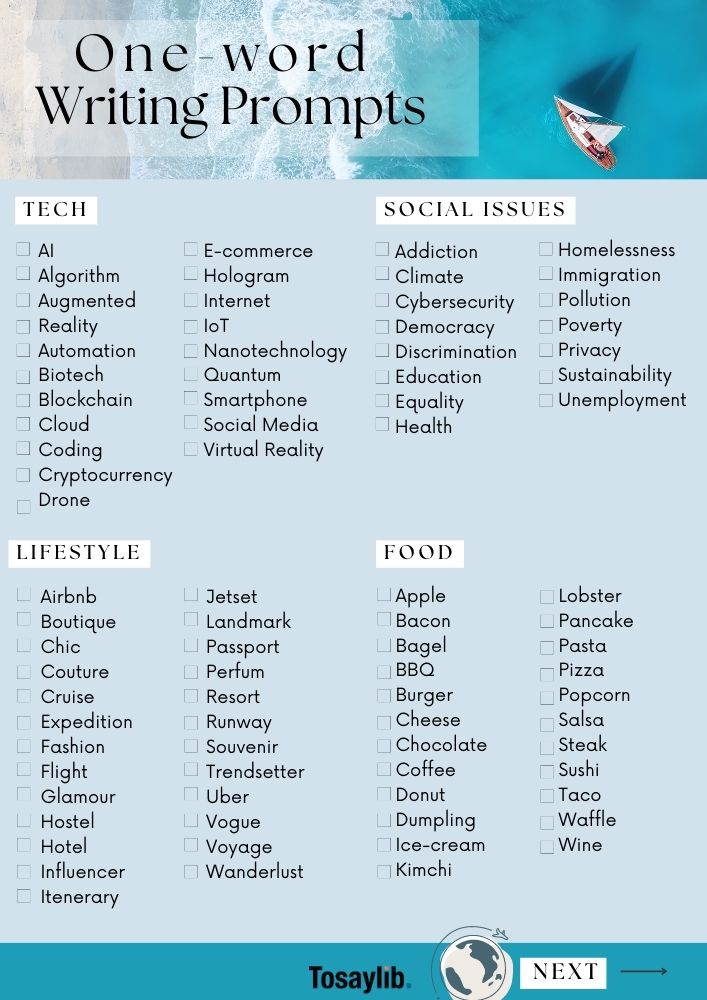
25 of the Best Words to Describe the Almighty Sun
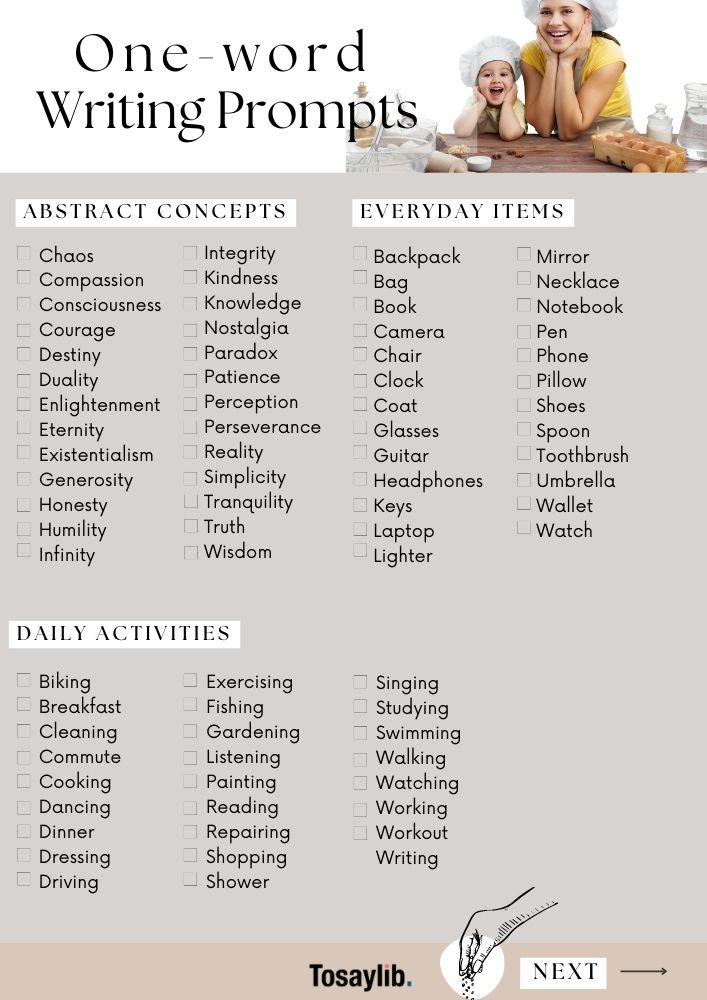
Discovering Your Own One-Word Prompts in Everyday Life

Raising a Glass: 8 Hilarious Maid of Honor Speeches for Your Best Friend’s Wedding
One-word writing prompts offer boundless possibilities for interpretation
- It could be interpreted as a literal rainstorm happening outside, with rain pouring down like cats and dogs.
- It could be seen as tears streaming down someone’s face, symbolizing intense emotions.
- It could be metaphorically used to represent a challenging period in a character’s life, where they find solace in dancing in the rain.
These examples demonstrate the diverse directions in which a single prompt can take a story. Writers can explore various genres, from romantic dramas to thrilling sci-fi adventures, all stemming from the same prompt. The potential for creativity is limitless. Let’s take a look at some examples to showcase the diverse interpretations that our collection of one-word prompts can inspire.
One-word prompts about tech

Writing prompts about social issues topics

One-word writing prompts centered on lifestyle

One-word writing prompts about food topics
One-word animal prompts:, prompts in the realm of money, prompts related to mystery subjects.

Prompts about well-being topics:

One-word abstract concept prompts

Single word prompts about everyday items

One-word prompts regarding daily activities

One-word prompts about time and places

Prompts on emotions and feelings

Writing prompts centered around human experience topics

One-word prompts related to relationships and interactions

One-word prompts based on sensory experiences
Nature-inspired one-word prompts.

Conclusion: Embrace the Power of Simplicity
bwerpipes in kalar
Tuesday 16th of April 2024
Maximize Water Efficiency with Bwer Pipes' Irrigation Solutions: At Bwer Pipes, we understand the importance of water conservation in Iraqi agriculture. That's why our irrigation systems minimize water wastage while delivering precise hydration to your crops. Experience the difference with Bwer Pipes. Visit Bwer Pipes
suscripción iptv
Sunday 24th of March 2024
I just could not depart your web site prior to suggesting that I really loved the usual info an individual supply in your visitors? Is gonna be back regularly to check up on new posts.
- Idea Generators
512 One-Word Writing Prompts
You know how sometimes you want to write, but you’re stuck on what to write about? Happens to the best of us! But guess what? We got something super cool for you, over 500 one-word writing prompts! Yup, just one word, and you’re off on a creative adventure. It’s like having a treasure chest full of ideas ready to spark your imagination. Trust me, with these prompts, you’ll never run out of writing inspiration again! Let’s dive in and see where your pen takes you!
One-Word Prompt Generator
Use our quick single-word prompt generator to get a random word to use in your writing:
One-word prompts are fantastic because they give you the freedom to interpret and explore in your own unique way. You know what they say, “less is more,” and that’s true here too.
With just one word, your mind goes wild, connecting ideas you never thought possible. Plus, they’re super time-saving and perfect for those days when you’re short on inspiration. Whether you’re a seasoned writer or just getting started, these prompts are a game-changer. They’re versatile, fun, and can lead you down unexpected writing paths. So why not give them a shot? You can even take part in our daily word challenge to practice your skills.
How to Use One-Word Prompts
Using these one-word prompts is a breeze and loads of fun!
- First off, grab yourself a list of one-word topics. You can find them in this post or even make your own.
- Next, find a cosy spot, get your favourite writing tools ready, and take a deep breath.
- Now, randomly pick a word from the list or let your gut guide you to the one that jumps out at you.
- Ready? Set! Write! Don’t overthink it; just let the word work its magic. You can go wild with a short story, delve into poetry, or even kickstart a journal entry.
The best part is there’s no right or wrong way to use these prompts. Let your creativity loose, and remember, it’s all about having a blast and honing your writing skills along the way.
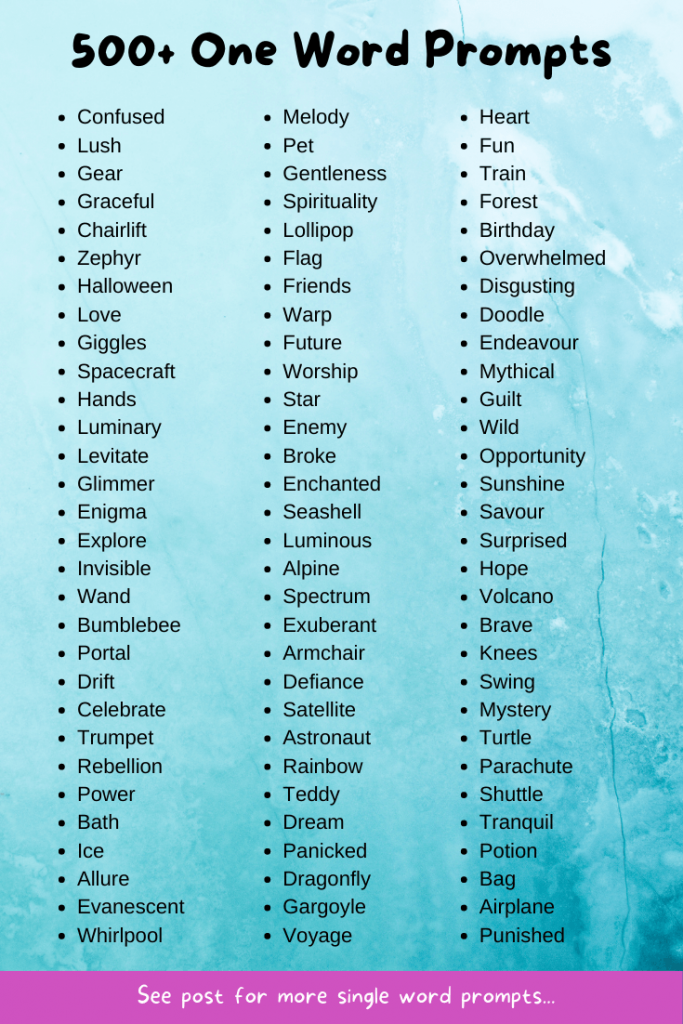
You might also be interested in viewing this list of words that start with X or this list of the funniest words in the English dictionary for more ideas.
One Word Prompts List
Below is a list of random words. Pick one or a couple to use as inspiration for your next story, poem or journal entry:
- Spirituality
- Tranquillity
- Overwhelmed
- Opportunity
- Misunderstood
- Discredited
- Celebration
- Time-travel
- Discoveries
- Ambivalence
- Undesirable
- Incandescent
- Mellifluous
- Reverberate
- Serendipity
- Marshmallow
- Inquisitive
- Spectacular
- Incantation
- Flabbergasted
- Caterpillar
Did you find this list of one-word writing prompts inspirational? Let us know in the comments below.

Marty the wizard is the master of Imagine Forest. When he's not reading a ton of books or writing some of his own tales, he loves to be surrounded by the magical creatures that live in Imagine Forest. While living in his tree house he has devoted his time to helping children around the world with their writing skills and creativity.
Related Posts

Comments loading...
- Write great papers Article
- Captivate the class Article
- Stage your story Article

Write great papers
Write great papers with microsoft word.
You may already use Microsoft Word to write papers, but you can also use for many other tasks, such as collecting research, co-writing with other students, recording notes on-the-fly, and even building a better bibliography!
Explore new ways to use Microsoft Word below.
Getting started
Let’s get started by opening Microsoft Word and choosing a template to create a new document. You can either:
Select Blank document to create a document from scratch.
Select a structured template.
Select Take a tour for Word tips.
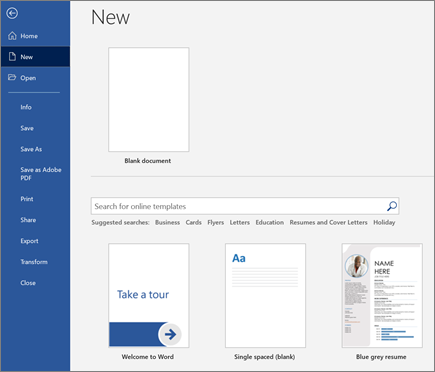
Next, let’s look at creating and formatting copy. You can do so by clicking onto the page and beginning to type your content. The status bar at the bottom of the document shows your current page number and how many words you've typed, in case you’re trying to stay maintain a specific word count.

To format text and change how it looks, select the text and select an option on the Home tab: Bold, Italic, Bullets, Numbering , etc.
To add pictures, shapes, or other media, simply navigate to the Insert tab, then select any of the options to add media to your document.
Word automatically saves your content as you work, so you don’t have to stress about losing your progress if you forget to press Save .
Here are some of the advanced tools you can try out while using Microsoft Word.
Type with your voice
Have you ever wanted to speak, not write, your ideas? Believe it or not, there’s a button for that! All you have to do is navigate to the Home tab, select the Dictate button, and start talking to “type” with your voice. You’ll know Dictate is listening when the red recording icon appears.
Tips for using Dictate
Speak clearly and conversationally.
Add punctuation by pausing or saying the name of the punctuation mark.
If you make a mistake, all you have to do is go back and re-type your text.
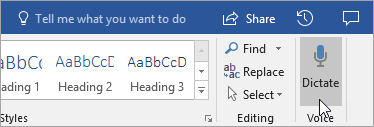
Finding and citing sources
Get a head start on collecting sources and ideas for a big paper by searching key words in Researcher in the References tab of your document.
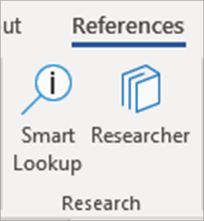
Researcher uses Bing to search the web and deliver high-quality research sources to the side of your page. Search for people, places, or ideas and then sort by journal articles and websites. Add a source to your page by selecting the plus sign.
As you write, Researcher saves a record of your searches. Just select My Research to see the complete list.
Keep track of all your sources by using Word's built-in bibliography maker. Simply navigate to the References tab.
First, choose the style you want your citations to be in. In this example, we’ve selected APA style.
Select Insert Citation and Add New Source .
In the next window, choose what kind of work you’re citing—an article, book, etc.—and fill in the required details. Then select OK to cite your source.
Keep writing. At the ends of sentences that need sources, select Insert Citation to keep adding new sources, or pick one you already entered from the list.
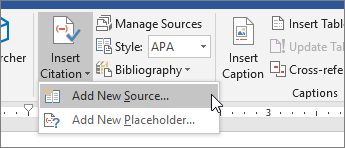
As you write, Word will keep track of all the citations you’ve entered. When you’re finished, select Bibliography and choose a format style. Your bibliography will appear at the end of your paper, just like that.
Make things look nice
Make your report or project look extra professional in the Design tab! Browse different themes, colors, fonts, and borders to create work you're proud of!
Illustrate a concept with a chart or a model by navigating to the Insert tab and choosing SmartArt . In this example, we chose Cycle and filled in text from the writing process to make a simple graphic. Choose other graphic types to represent hierarchies, flow charts, and more.
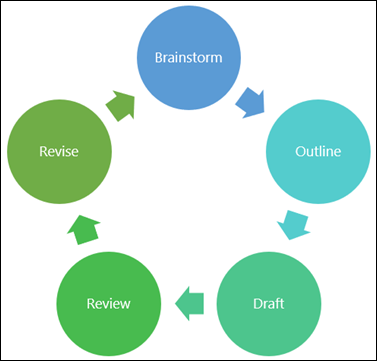
To insert a 3D model, select Insert > 3D Models to choose from a library of illustrated dioramas from different course subjects and 3D shapes.
Invite someone to write with you
If you’re working on a group project, you can work on a document at the same time without emailing the file back and forth. Select Share at the top of your page and create a link you can send to other students.
Now, everybody can open the same file and work together.
Keep learning
Check out more Microsoft Word training and support
Microsoft paper and report templates

Need more help?
Want more options.
Explore subscription benefits, browse training courses, learn how to secure your device, and more.

Microsoft 365 subscription benefits

Microsoft 365 training

Microsoft security

Accessibility center
Communities help you ask and answer questions, give feedback, and hear from experts with rich knowledge.

Ask the Microsoft Community

Microsoft Tech Community

Windows Insiders
Microsoft 365 Insiders
Was this information helpful?
Thank you for your feedback.
Essay on Earth
500 words essay on earth.
The earth is the planet that we live on and it is the fifth-largest planet. It is positioned in third place from the Sun. This essay on earth will help you learn all about it in detail. Our earth is the only planet that can sustain humans and other living species. The vital substances such as air, water, and land make it possible.

All About Essay on Earth
The rocks make up the earth that has been around for billions of years. Similarly, water also makes up the earth. In fact, water covers 70% of the surface. It includes the oceans that you see, the rivers, the sea and more.
Thus, the remaining 30% is covered with land. The earth moves around the sun in an orbit and takes around 364 days plus 6 hours to complete one round around it. Thus, we refer to it as a year.
Just like revolution, the earth also rotates on its axis within 24 hours that we refer to as a solar day. When rotation is happening, some of the places on the planet face the sun while the others hide from it.
As a result, we get day and night. There are three layers on the earth which we know as the core, mantle and crust. The core is the centre of the earth that is usually very hot. Further, we have the crust that is the outer layer. Finally, between the core and crust, we have the mantle i.e. the middle part.
The layer that we live on is the outer one with the rocks. Earth is home to not just humans but millions of other plants and species. The water and air on the earth make it possible for life to sustain. As the earth is the only livable planet, we must protect it at all costs.
Get the huge list of more than 500 Essay Topics and Ideas
There is No Planet B
The human impact on the planet earth is very dangerous. Through this essay on earth, we wish to make people aware of protecting the earth. There is no balance with nature as human activities are hampering the earth.
Needless to say, we are responsible for the climate crisis that is happening right now. Climate change is getting worse and we need to start getting serious about it. It has a direct impact on our food, air, education, water, and more.
The rising temperature and natural disasters are clear warning signs. Therefore, we need to come together to save the earth and leave a better planet for our future generations.
Being ignorant is not an option anymore. We must spread awareness about the crisis and take preventive measures to protect the earth. We must all plant more trees and avoid using non-biodegradable products.
Further, it is vital to choose sustainable options and use reusable alternatives. We must save the earth to save our future. There is no Planet B and we must start acting like it accordingly.
Conclusion of Essay on Earth
All in all, we must work together to plant more trees and avoid using plastic. It is also important to limit the use of non-renewable resources to give our future generations a better planet.
FAQ on Essay on Earth
Question 1: What is the earth for kids?
Answer 1: Earth is the third farthest planet from the sun. It is bright and bluish in appearance when we see it from outer space. Water covers 70% of the earth while land covers 30%. Moreover, the earth is the only planet that can sustain life.
Question 2: How can we protect the earth?
Answer 2: We can protect the earth by limiting the use of non-renewable resources. Further, we must not waste water and avoid using plastic.
Customize your course in 30 seconds
Which class are you in.

- Travelling Essay
- Picnic Essay
- Our Country Essay
- My Parents Essay
- Essay on Favourite Personality
- Essay on Memorable Day of My Life
- Essay on Knowledge is Power
- Essay on Gurpurab
- Essay on My Favourite Season
- Essay on Types of Sports
Leave a Reply Cancel reply
Your email address will not be published. Required fields are marked *
Download the App


- Subscriber Login
Since 1900, the Christian Century has published reporting, commentary, poetry, and essays on the role of faith in a pluralistic society.
© 2023 The Christian Century.
Contact Us Privacy Policy
April 28, Easter 5B ( John 15:1–8; 1 John 4:7–21)
In biblical greek, the word we translate as “abide” is active rather than passive..
The hymn draws its main scriptural allusion from the narrative of the disciples’ walk to Emmaus and their post-resurrection encounter with Jesus, whom they do not recognize on the road but nonetheless urge to “abide with us, for it is toward evening, and the day is far spent” (Luke 24:29). The Greek word translated as “abide” is μεῖνον , which means simply “remain” or “stay.” But the word yields deeper meaning as well. In the New Testament, to abide is to participate in an ongoing process of renewal through one’s presence intermingled with another’s; in biblical Greek, the word is active rather than passive. It reflects not merely existing alongside another as a static entity but rather sharing in a common fellowship and mission. To abide one with another is to remain an active part of the whole community in an iterative fashion, over and over again, so as to maintain a life-giving, ongoing bond that will sustain a shared mission and purpose.
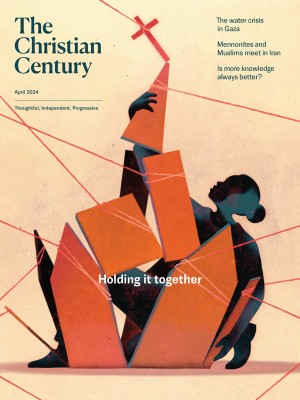
Equating each branch with a singular person is a mistake I hope those called to proclaim good news will avoid. Instead we can think more holistically, regarding the branches cut away as the parts of our shared mission that no longer bear fruit, such that pruning them redirects nourishing resources to branches that still hold potential for thriving.
Not a brief glance I beg, a passing word, But as Thou dwell’st with Thy disciples, Lord, Familiar, condescending, patient, free. Come not to sojourn, but abide with me.
Austin Shelley
Austin Shelley is senior pastor of Shadyside Presbyterian Church in Pittsburgh.
We would love to hear from you. Let us know what you think about this article by emailing our editors .
Most Recent
A refugee’s fragmented memory, psalm 23 in conversation (acts 4:5-12; psalm 23; 1 john 3:16-24; john 10:11-18).
by Austin Shelley
Centering Chloe and decentering Paul
Border encounters, most popular.

Early Christianity, fragment by fragment
April 21, easter 4b ( psalm 23; john 10:11–18).

How might God bless a divided America?

The buddy-cop feminist detective series I didn’t know I needed
Essay on Love
Here we have shared the Essay on Love in detail so you can use it in your exam or assignment of 150, 250, 400, 500, or 1000 words.
You can use this Essay on Love in any assignment or project whether you are in school (class 10th or 12th), college, or answer writing for competitive exams.
Topics covered in this article.
Essay on Love in 150-250 words
Essay on love in 300-450 words, essay on love in 500-1000 words.
Love is a powerful and universal emotion that transcends boundaries and brings people together. It is an intense feeling of affection, care, and compassion towards someone or something. Love can exist in various forms, including romantic love, love for family and friends, and love for humanity.
Love has the ability to inspire and transform individuals. It brings joy, happiness, and a sense of fulfillment to our lives. Love nurtures relationships, fosters understanding, and creates bonds of trust and loyalty. It encourages selflessness, empathy, and acts of kindness.
Love is not limited to romantic relationships; it extends to the love we have for our families and friends. It is the foundation of strong, supportive, and nurturing relationships. Love for our families provides a sense of belonging, security, and unconditional support. Love for our friends brings companionship, laughter, and shared experiences.
Love also has the power to transcend personal relationships and extend to the broader community. Love for humanity motivates acts of kindness, compassion, and service to others. It inspires individuals to work towards social justice, equality, and the well-being of all.
In conclusion, love is a beautiful and transformative emotion that connects individuals and enhances the quality of our lives. It fosters deep relationships, brings joy and fulfillment, and motivates acts of kindness and service. Love is a powerful force that binds us together, promotes understanding, and creates a sense of belonging in our world.
Love is a complex and profound emotion that has been a subject of fascination and exploration throughout human history. It is a deep affection and care that we feel for someone or something, transcending boundaries and connecting us on a fundamental level.
Love can manifest in various forms, including romantic love, love for family and friends, and love for humanity. Romantic love is characterized by intense emotions, attraction, and a desire for companionship and intimacy. It brings joy, passion, and a sense of completeness to our lives. Love for family and friends is built on a foundation of trust, loyalty, and support. It creates strong bonds of connection, shared experiences, and a sense of belonging. Love for humanity is a broader form of love that encompasses empathy, compassion, and a commitment to the well-being of others.
Love has the power to transform individuals and relationships. It fosters personal growth, empathy, and understanding. Love encourages selflessness, as we prioritize the needs and happiness of our loved ones. It teaches us to be patient, forgiving, and accepting of both the strengths and flaws of those we care about. Love helps us navigate the challenges and complexities of relationships, as we communicate, compromise, and work together towards mutual growth and happiness.
Love is not without its challenges, as it can also bring vulnerability, heartbreak, and loss. However, it is through these challenges that love reveals its resilience and strength. Love gives us the courage to overcome obstacles, mend broken bonds, and heal emotional wounds. It teaches us valuable lessons about forgiveness, resilience, and the power of connection.
Ultimately, love is an essential part of the human experience. It brings richness, meaning, and joy to our lives. Love fosters deep connections, encourages personal growth, and inspires acts of kindness and compassion. It is a force that transcends differences and unites us in our shared humanity. In a world that often seems divided, love has the potential to bridge gaps, foster understanding, and create a more compassionate and harmonious society.
In conclusion, love is a complex and transformative emotion that enriches our lives in profound ways. It is a universal language that connects us to one another and reminds us of our shared humanity. Whether in romantic relationships, familial bonds, or our love for humanity, love has the power to bring happiness, growth, and connection. By cultivating love in our lives, we can create a world filled with compassion, understanding, and genuine human connections.
Title: Love – The Universal Language of Connection and Fulfillment
Introduction :
Love is a powerful and universal emotion that transcends cultural, geographical, and linguistic boundaries. It is a complex and multifaceted phenomenon that has been the subject of artistic, philosophical, and scientific exploration throughout human history. Love is a fundamental aspect of the human experience, shaping our relationships, influencing our choices, and bringing joy, fulfillment, and meaning to our lives. In this essay, we will delve into the various dimensions of love, its impact on our well-being, its different forms, and its role in fostering connection and personal growth.
Love and Connection
Love is intricately linked to the idea of connection. It is a force that binds us together, fostering deep relationships and creating a sense of belonging. Love enables us to form emotional connections with others, resulting in companionship, support, and mutual understanding. It allows us to experience empathy and compassion, connecting us on an emotional level and forging bonds of trust and loyalty. Love nurtures relationships, creating an environment of emotional safety and acceptance, where individuals can express themselves fully and be embraced for who they are.
Forms of Love
Love manifests in various forms, each with its own unique characteristics and dynamics. Romantic love is often the first form of love that comes to mind, characterized by intense passion, attraction, and a desire for emotional and physical intimacy. It is a deep connection between two individuals, rooted in shared values, interests, and mutual respect.
Love for family is another powerful form of love. It encompasses the bond between parents and children, siblings, and extended family members. Family love is often unconditional, built on a foundation of support, sacrifice, and a shared history. It offers a sense of belonging, security, and the comfort of knowing that one is part of a loving and nurturing unit.
Love for friends is a special kind of bond that goes beyond blood relations. Friends become our chosen family, offering companionship, laughter, and a support system outside of our immediate relatives. Friendship love is built on trust, shared experiences, and mutual respect. It is a source of emotional support, encouragement, and the joy of companionship.
Love for humanity is a broader form of love that transcends individual relationships. It encompasses compassion, empathy, and a sense of responsibility towards the well-being and dignity of all human beings. This form of love drives individuals to contribute to the betterment of society, fight for social justice, and promote equality and inclusivity.
Love and Personal Growth
Love has the power to transform individuals and facilitate personal growth. It encourages self-reflection, as we learn about our own strengths, weaknesses, and vulnerabilities through our connections with others. Love challenges us to become better versions of ourselves, as we strive to be more patient, understanding, and supportive in our relationships. It teaches us important lessons about forgiveness, empathy, and compromise.
Love also provides a source of inspiration and motivation. When we feel loved and supported, we gain the confidence to pursue our dreams, take risks, and explore our potential. Love provides a sense of security and a safe space for personal exploration, allowing us to embrace our true selves and express our authentic thoughts and emotions.
Furthermore, love fosters resilience in the face of adversity. It gives us the strength to overcome challenges, as we draw upon the love and support of those who care for us. Love provides a source of comfort and emotional stability, helping us navigate difficult times with resilience and determination.
Love and Well-being
Love plays a vital role in our overall well-being and mental health. Studies have shown that individuals who experience love and emotional support tend to have lower levels of stress, anxiety, and depression. Love provides a buffer against the challenges of life, offering emotional reassurance, a sense of belonging, and a feeling of being understood and valued. Love also contributes to our physical health. The emotional support and connection that love brings can have positive effects on our immune system, cardiovascular health, and overall longevity. Love promotes a sense of happiness, contentment, and a positive outlook on life, all of which contribute to improved well-being.
Furthermore, love encourages positive social interactions and a sense of community. It fosters social connections, strengthens social support networks, and reduces feelings of loneliness and isolation. Love promotes a sense of belonging and connectedness to others, which is essential for our mental and emotional well-being.
Love and Cultural Expression
Love has been a central theme in art, literature, music, and various cultural expressions throughout history. Artists and creatives have explored the depth and complexity of love, capturing its essence through different mediums. Love has inspired countless poems, songs, paintings, and sculptures, reflecting its profound impact on human experience and emotion.
Cultural norms and traditions also shape the expression of love in different societies. Love rituals, such as weddings, celebrations, and ceremonies, are often an integral part of cultural practices. These rituals symbolize and reinforce the commitment, connection, and bond shared by individuals and communities.
Love and its Challenges
While love brings immense joy and fulfillment, it is not without its challenges. Love requires effort, communication, and compromise. It involves vulnerability, as we open ourselves up to the possibility of rejection, heartbreak, and loss. Love requires us to navigate differences, conflicts, and changing dynamics within relationships. However, it is through these challenges that love grows stronger, as individuals learn and grow together, developing deeper levels of understanding and resilience.
Conclusion :
Love is a fundamental and universal force that permeates every aspect of our lives. It connects us to others, fosters personal growth, contributes to our well-being, and shapes our cultural expressions. Love brings joy, meaning, and a sense of purpose to our existence. It is a language that transcends barriers, bridging divides, and uniting individuals and communities. As we navigate life’s complexities, love offers us solace, support, and the transformative power to create a more compassionate and harmonious world.
Related Posts
- Essay on Pollution
- Essay on “Impact of Social Media on Youth”

Essential Elements of Valid Contract (Explained With Examples)

What is World Population? Main Causes, Effects, Top 20 Countries

25,000+ students realised their study abroad dream with us. Take the first step today
Meet top uk universities from the comfort of your home, here’s your new year gift, one app for all your, study abroad needs, start your journey, track your progress, grow with the community and so much more.

Verification Code
An OTP has been sent to your registered mobile no. Please verify

Thanks for your comment !
Our team will review it before it's shown to our readers.

- School Education /
One Nation One Election Essay in 500+ Words
- Updated on
- Feb 1, 2024

One Nation One Election Essay: The main idea of the “One Nation One Election (ONOE)” is to have all Vidhan Sabha or state elections happen at the same time as the Lok Sabha or general elections every five years. This concept aims to make the electoral process more efficient by reducing the number of elections and saving time and resources.

In India, the concept of ONOE has been around since 1983. It was proposed by the then Election Commission of India (ECI) . However, before 1967, India regularly conducted simultaneous elections. The first time general elections and state legislative assembly elections were held together was in 1951-52. This practice continued in 1957, 1962, and 1967.
Unfortunately, due to the early dissolution of some Legislative Assemblies in 1968 and 1969, the cycle was disrupted. In 1970, the Lok Sabha itself was dissolved prematurely, leading to fresh elections in 1971. So, until 1970, only the First, Second, and Third Lok Sabha completed full five-year terms.
Also Read: Essay on Bhimrao Ambedkar in 500 Words
Resurfacing of One Nation One Election
After many decades, the idea of “One Nation One Election” resurfaced again in 2023. In September 2023, the Union Government of India established a ‘High-Level Committee on ONOE’. The committee was chaired by former President of India Ramnath Kovind.
Since then, the committee has convened three times and gathered opinions from political parties and eminent jurists. While there is no set timeline for the committee’s recommendations, the fact that it aligns with the lead-up to the 2024 general elections raises concerns. Given the potential to reshape the democratic structure and federal system , it is crucial to promptly analyze the legal aspects of this initiative.
Also Read: Essay on Democracy in 100, 300 and 500 Words
Countries following One Nation One Election
Many countries like Sweden and South America follow the One Nation One Election policy. In Sweden, elections are conducted according to a fixed schedule. The elections for the provincial legislature (Landsting), local bodies (Kommunfullmaktige), and national legislature (Riksdag) are conducted every fourth year on a set date, specifically on the second Sunday in September.
Furthermore, in South Africa, elections for both the national and provincial legislatures take place simultaneously every five years. However, Municipal elections are held separately, occurring two years after the national and provincial elections.
Also Read: How is the Speaker of Lok Sabha Elected?
Advantages of One Nation One Election
The main advantage of ‘One Nation, One Election’ is the reduction in election costs, as each separate election requires a significant amount of financial resources. Also, simultaneous elections would allow the government to focus more on governance rather than being in election mode. With a reduced focus on elections all around the country, political parties in power can prioritize development over election campaigns.
Additionally, holding simultaneous elections would reduce the workload on administrative and security forces. Besides, ONOE will boost voter turnout because it will be easier for people to cast multiple ballots at once.
Also Read: What is Representative Democracy?
Modi Govt wants Democratic India to slowly turn it into a Dictatorship. This gimmick of forming a committee on 'One Nation, One Election' is a subterfuge for dismantling the Federal Structure of India. There will be at least five Amendments required in the Constitution of… — Mallikarjun Kharge (@kharge) September 3, 2023
Disadvantages of One Nation One Election
On the other hand, critics of unified elections in India believe that the cost of conducting free and fair elections to choose a government elected by the people is a price that should never be considered too high. They propound that having elections simultaneously undermines the autonomy and independence of state governments. This not only weakens the federal structure but also raises the potential for conflicts of interest between the central government and the states.
Also, implementing simultaneous elections presents big challenges, like making sure there are enough secure electronic voting machines, personnel, and other necessary resources.
Thus, we can conclude that despite being cost-effective and convenient, one nation one election is dangerous to a democratic country like India as it is a threat to the autonomy of the state governments. Besides, simultaneous elections would obstruct the growth of regional parties as as the spotlight on national issues during a unified electoral process may overshadow regional concerns.
Also Read: Essay on Indian Constitution in 100, 250, and 350 words
Ans: The then-President of India, Mr Ramnath Kovind, chaired the committee.
Ans: You can start by defining ONOE. Following this, you can mention the advantages and disadvantages of simultaneous elections. Also, you can explain its significance in the Indian context and other countries that conduct unified elections.
Ans: Sweden, South Africa, and Britain conduct simultaneous elections.
You can also explore:
Follow Leverage Edu for more interesting topics on school education and essay writing .
Ankita Singh
Ankita is a history enthusiast with a few years of experience in academic writing. Her love for literature and history helps her curate engaging and informative content for education blog. When not writing, she finds peace in analysing historical and political anectodes.
Leave a Reply Cancel reply
Save my name, email, and website in this browser for the next time I comment.
Contact no. *

Connect With Us

25,000+ students realised their study abroad dream with us. Take the first step today.

Resend OTP in

Need help with?
Study abroad.
UK, Canada, US & More
IELTS, GRE, GMAT & More
Scholarship, Loans & Forex
Country Preference
New Zealand
Which English test are you planning to take?
Which academic test are you planning to take.
Not Sure yet
When are you planning to take the exam?
Already booked my exam slot
Within 2 Months
Want to learn about the test
Which Degree do you wish to pursue?
When do you want to start studying abroad.
January 2024
September 2024
What is your budget to study abroad?

How would you describe this article ?
Please rate this article
We would like to hear more.
Have something on your mind?

Make your study abroad dream a reality in January 2022 with
India's Biggest Virtual University Fair

Essex Direct Admission Day
Why attend .

Don't Miss Out
- SUGGESTED TOPICS
- The Magazine
- Newsletters
- Managing Yourself
- Managing Teams
- Work-life Balance
- The Big Idea
- Data & Visuals
- Reading Lists
- Case Selections
- HBR Learning
- Topic Feeds
- Account Settings
- Email Preferences
6 Common Leadership Styles — and How to Decide Which to Use When
- Rebecca Knight

Being a great leader means recognizing that different circumstances call for different approaches.
Research suggests that the most effective leaders adapt their style to different circumstances — be it a change in setting, a shift in organizational dynamics, or a turn in the business cycle. But what if you feel like you’re not equipped to take on a new and different leadership style — let alone more than one? In this article, the author outlines the six leadership styles Daniel Goleman first introduced in his 2000 HBR article, “Leadership That Gets Results,” and explains when to use each one. The good news is that personality is not destiny. Even if you’re naturally introverted or you tend to be driven by data and analysis rather than emotion, you can still learn how to adapt different leadership styles to organize, motivate, and direct your team.
Much has been written about common leadership styles and how to identify the right style for you, whether it’s transactional or transformational, bureaucratic or laissez-faire. But according to Daniel Goleman, a psychologist best known for his work on emotional intelligence, “Being a great leader means recognizing that different circumstances may call for different approaches.”
- RK Rebecca Knight is a journalist who writes about all things related to the changing nature of careers and the workplace. Her essays and reported stories have been featured in The Boston Globe, Business Insider, The New York Times, BBC, and The Christian Science Monitor. She was shortlisted as a Reuters Institute Fellow at Oxford University in 2023. Earlier in her career, she spent a decade as an editor and reporter at the Financial Times in New York, London, and Boston.
Partner Center
Advertisement
Shadow War Between Iran and Israel: A Timeline
A recent round of strikes has brought the conflict more clearly into the open and raised fears of a broader war.
- Share full article

By Cassandra Vinograd
- April 19, 2024
For decades, Israel and Iran have fought a shadow war across the Middle East , trading attacks by land, sea, air and in cyberspace. A recent round of strikes — mainly an aerial barrage by Iran against Israel last weekend — has brought the conflict more clearly into the open and raised fears of a broader war.
A retaliatory Israeli strike on an Iranian air base on Friday, however, appeared limited in scope, and analysts said it suggested an effort to pull back from the dangerous cycle and potentially move the war back into the shadows.
Here is a recent history of the conflict:
August 2019: An Israeli airstrike killed two Iranian-trained militants in Syria, a drone set off a blast near a Hezbollah office in Lebanon and an airstrike in Qaim, Iraq, killed a commander of an Iran-backed Iraqi militia. Israel accused Iran at the time of trying to establish an overland arms-supply line through Iraq and northern Syria to Lebanon, and analysts said the strikes were aimed at stopping Iran and signaling to its proxies that Israel would not tolerate a fleet of smart missiles on its borders.
January 2020: Israel greeted with satisfaction the assassination of Maj. Gen. Qassim Suleimani , the commander of the foreign-facing arm of Iran’s Islamic Revolutionary Guards Corps, in an American drone strike in Baghdad.
Iran hit back by attacking two bases in Iraq that housed American troops with a barrage of missiles, wounding about 100 U.S. military personnel .
2021-22: In July 2021, an oil tanker managed by an Israeli-owned shipping company was attacked off the coast of Oman, killing two crew members, according to the company and three Israeli officials. Two of the officials said that the attack appeared to have been carried out by Iranian drones.
Iran did not explicitly claim or deny responsibility, but a state-owned television channel described the episode as a response to an Israeli strike in Syria.
In November 2021, Israel killed Iran’s top nuclear scientist, Mohsen Fakhrizadeh , and followed up with the assassination of a Revolutionary Guards commander, Col. Sayad Khodayee , in May 2022.
December 2023: After Israel’s bombardment of Gaza began in response to the Oct. 7 Hamas-led assault, Iranian-backed militias stepped up their own attacks . And late last year, Iran accused Israel of killing a high-level military figure, Brig. Gen. Sayyed Razi Mousavi , in a missile strike in Syria.
A senior adviser to the Revolutionary Guards, General Mousavi was described as having been a close associate of General Suleimani and was said to have helped oversee the shipment of arms to Hezbollah. Israel, adopting its customary stance, declined to comment directly on whether it was behind General Mousavi’s death.
January 2024: An explosion in a suburb of Beirut, Lebanon, killed Saleh al-Arouri , a Hamas leader, along with two commanders from that group’s armed wing, the first assassination of a top Hamas official outside the West Bank and Gaza in recent years. Officials from Hamas, Lebanon and the United States ascribed the blast to Israel , which did not publicly confirm involvement.
Hezbollah, which receives major support from Iran, stepped up its assaults on Israel after Mr. al-Arouri’s death. Israel’s military hit back at Hezbollah in Lebanon, killing several of the group’s commanders .
March: An Israeli drone strike hit a car in southern Lebanon, killing at least one person. Israel’s military said it had killed the deputy commander of Hezbollah’s rocket and missile unit. Hezbollah acknowledged the death of a man, Ali Abdulhassan Naim, but did not provide further details.
The same day, airstrikes killed soldiers near Aleppo, northern Syria, in what appeared to be one of the heaviest Israeli attacks in the country in years. The strikes killed 36 Syrian soldiers, seven Hezbollah fighters and a Syrian from a pro-Iran militia, according to the Syrian Observatory for Human Rights, a British-based group that tracks Syria’s civil war.
Israel’s military did not claim responsibility. But the country’s defense minister, Yoav Gallant, wrote on social media, “We will pursue Hezbollah every place it operates and we will expand the pressure and the pace of the attacks.”
April: A strike on an Iranian Embassy building in Damascus on April 1 killed three top Iranian commanders and four officers. Iran blamed Israel and vowed to hit back forcefully.
Two weeks later, Tehran launched a barrage of more than 300 drones and missiles at Israel, an unexpectedly large-scale attack , although nearly all the weapons were shot down by Israel and allies. Israel said for days it would respond, before a strike on Friday hit a military air base near the central Iranian city of Isfahan.

IMAGES
VIDEO
COMMENTS
One-Word Essays. The good thing about one word essays is that you can write it as a narrative, as an inspirational essay or as an essay describing an attribute of life. Starting the essay: Add a quote relevant to the topic, it generally helps. Don't just make up bizarre quotes, if you know a quote then add it, if you don't then no problem.
If you're struggling to choose the right words for your essay, don't worry—you've come to the right place! In this article, we've compiled a list of over 300 words and phrases to use in the introduction, body, and conclusion of your essay. Contents: Words to Use in the Essay Introduction. Words to Use in the Body of the Essay.
4. That is to say. Usage: "That is" and "that is to say" can be used to add further detail to your explanation, or to be more precise. Example: "Whales are mammals. That is to say, they must breathe air.". 5. To that end. Usage: Use "to that end" or "to this end" in a similar way to "in order to" or "so".
This essay begins by discussing the situation of blind people in nineteenth-century Europe. It then describes the invention of Braille and the gradual process of its acceptance within blind education. ... Text was one of the primary methods through which people engaged with culture, communicated with others, and accessed information; without a ...
Table of contents. Essay 1: Sharing an identity or background through a montage. Essay 2: Overcoming a challenge, a sports injury narrative. Essay 3: Showing the influence of an important person or thing. Other interesting articles. Frequently asked questions about college application essays.
Make a claim. Provide the grounds (evidence) for the claim. Explain the warrant (how the grounds support the claim) Discuss possible rebuttals to the claim, identifying the limits of the argument and showing that you have considered alternative perspectives. The Toulmin model is a common approach in academic essays.
Sharing is caring! How to Write a Great Essay in English! This lesson provides 100+ useful words, transition words and expressions used in writing an essay. Let's take a look! The secret to a successful essay doesn't just lie in the clever things you talk about and the way you structure your points.
One of the most common is the comparison/contrast essay, in which you focus on the ways in which certain things or ideas—usually two of them—are similar to (this is the comparison) and/or different from (this is the contrast) one another. By assigning such essays, your instructors are encouraging you to make connections between texts or ...
To do this, use any of the below words or phrases to help keep you on track. 1. Firstly, secondly, thirdly. Even though it sounds obvious, your argument will be clearer if you deliver the ideas in the right order. These words can help you to offer clarity and structure to the way you expose your ideas.
Here are some ideas on how to use these one-word prompts: Write each word on a slip of paper and draw one from a jar each day. Draw two or three for an extra challenge, or. Keep the same word for multiple days, writing something different each day. Place your memorized word under a candle and light it before you begin.
Transitions. Transitions help your readers move between ideas within a paragraph, between paragraphs, or between sections of your argument. When you are deciding how to transition from one idea to the next, your goal should be to help readers see how your ideas are connected—and how those ideas connect to the big picture.
One-word writing prompts can evoke a range of emotions and ideas, allowing you to explore numerous angles and perspectives. Check out the list below, full of different social issue topics, ready to become the seeds of your next piece of writing. 1. Immigration. A mystery revolving around an immigration scam.
Conclusion. In conclusion, one-word writing prompts can be a powerful tool for writers to challenge themselves, get their creative juices flowing, and explore new story ideas. With this list of one-word writing prompts, you have plenty of inspiration to choose from, whether you're working on a novel, a short story, a screenplay, a memoir, or a ...
For a high school essay, this could be just three paragraphs, but for a graduate school essay of 6,000 words, the body could take up 8-10 pages. Paragraph structure. To give your essay a clear structure, it is important to organize it into paragraphs. Each paragraph should be centered around one main point or idea.
One-Word Prompt Generator. Use our quick single-word prompt generator to get a random word to use in your writing: Click the 'Random' button to get a one-word prompt. One-word prompts are fantastic because they give you the freedom to interpret and explore in your own unique way. You know what they say, "less is more," and that's true ...
Finding and citing sources. Get a head start on collecting sources and ideas for a big paper by searching key words in Researcher in the References tab of your document. Researcher uses Bing to search the web and deliver high-quality research sources to the side of your page. Search for people, places, or ideas and then sort by journal articles and websites.
500 Words Essay On Earth. The earth is the planet that we live on and it is the fifth-largest planet. It is positioned in third place from the Sun. ... The earth moves around the sun in an orbit and takes around 364 days plus 6 hours to complete one round around it. Thus, we refer to it as a year. Just like revolution, the earth also rotates on ...
The accompanying lectionary passage from 1 John 4 takes the promise of the Lord's abiding presence to heart and goes a step farther. Abiding in God's love, we are equipped and freed to love one another. It is Jesus' ongoing love for his disciples that frees us to love one another in his name. Thus may we pray for God's abiding and ...
Table of Contents [ hide] 1 I Love My India Essay 100 Words. 2 I Love My India Essay 500+ Words. 2.1 Contribution and Celebration For the World. 2.2 Aiming for the 3rd Largest Economy. 2.3 Caring For a Bright Future. 2.4 Conclusion. 3 FAQs.
Then, on a pad of paper or a word processor, write continuously for two or three minutes. Don't stop, not even for a moment. Write down anything that comes to mind, no matter how nonsensical it seems, as long as it somehow relates to the topic you began with. If you need to, time yourself to make sure you write for a few minutes straight.
Essay on Love in 150-250 words. Love is a powerful and universal emotion that transcends boundaries and brings people together. It is an intense feeling of affection, care, and compassion towards someone or something. Love can exist in various forms, including romantic love, love for family and friends, and love for humanity.
Also Read: Essay on Bhimrao Ambedkar in 500 Words. Resurfacing of One Nation One Election . After many decades, the idea of "One Nation One Election" resurfaced again in 2023. In September 2023, the Union Government of India established a 'High-Level Committee on ONOE'. The committee was chaired by former President of India Ramnath Kovind.
The basic structure of an essay always consists of an introduction, a body, and a conclusion. But for many students, the most difficult part of structuring an essay is deciding how to organize information within the body. This article provides useful templates and tips to help you outline your essay, make decisions about your structure, and ...
Much has been written about common leadership styles and how to identify the right style for you, whether it's transactional or transformational, bureaucratic or laissez-faire. But according to ...
April 19, 2024, 11:02 a.m. ET. For decades, Israel and Iran have fought a shadow war across the Middle East, trading attacks by land, sea, air and in cyberspace. A recent round of strikes ...
Essay length guidelines. Type of essay. Average word count range. Essay content. High school essay. 300-1000 words. In high school you are often asked to write a 5-paragraph essay, composed of an introduction, three body paragraphs, and a conclusion. College admission essay. 200-650 words.